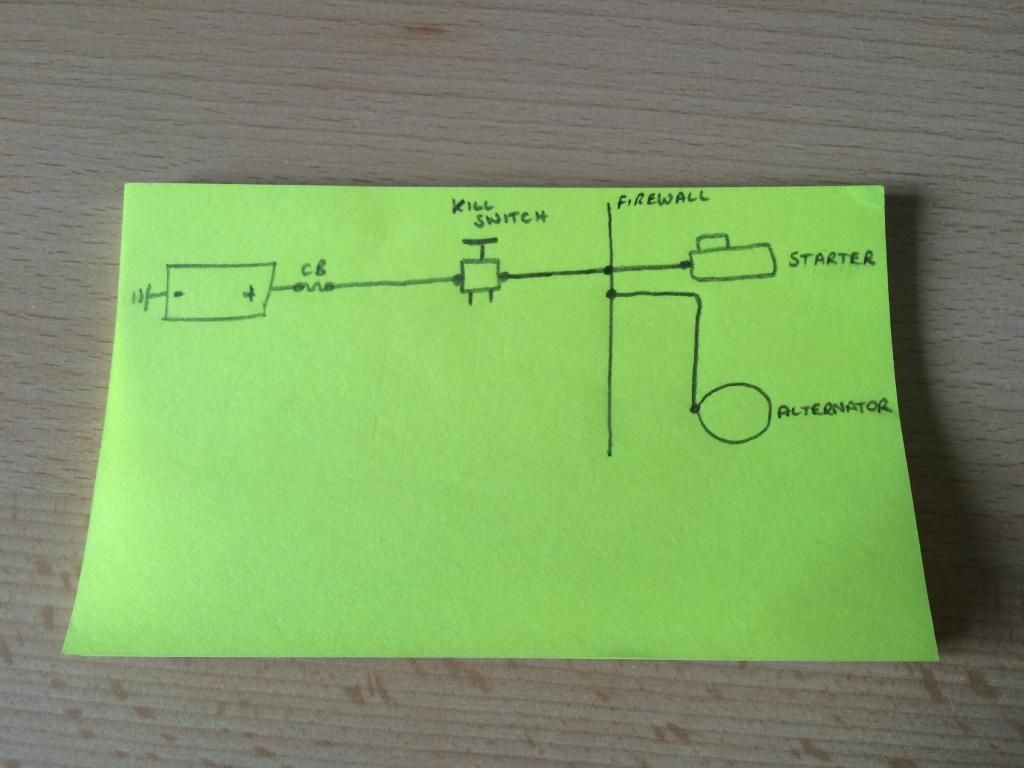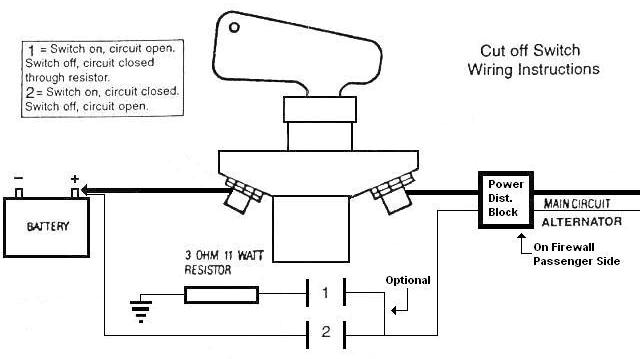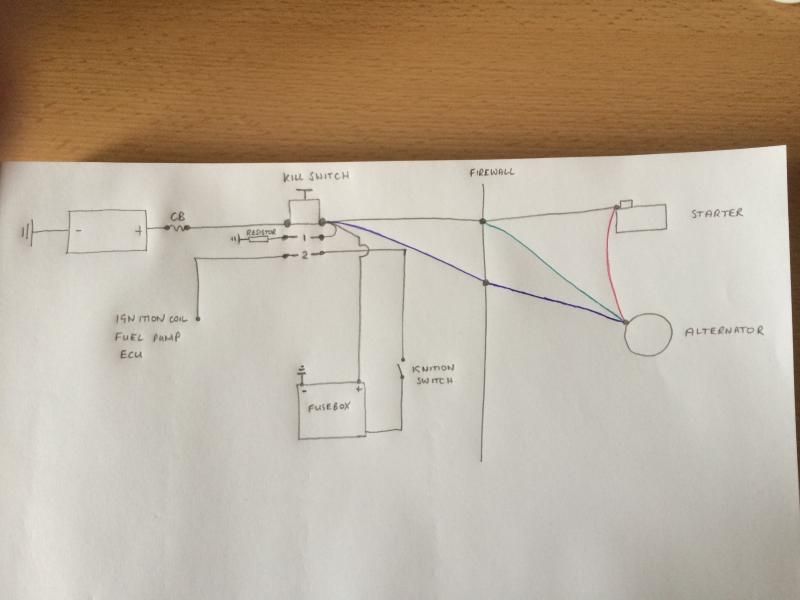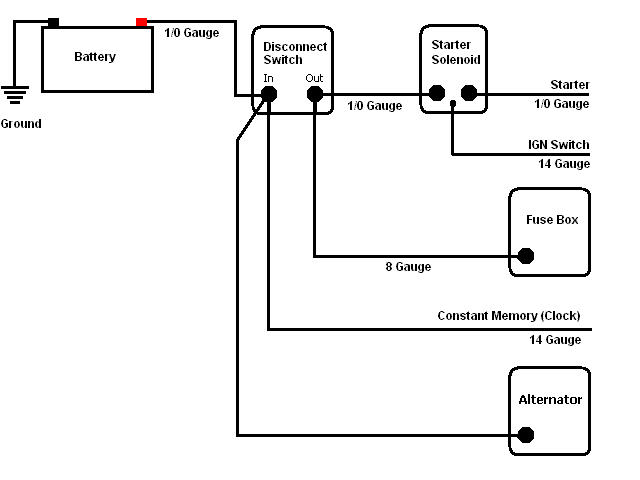benjy_b
Yorkshire and The Humber
Posts: 409
|
|
Jan 13, 2015 12:10:58 GMT
|
In the interest of keeping this to the point... I am in a very long winded process of altering the wiring on the Corolla using: 1983 Toyota Corolla Chassis Loom 2000 Honda S2000 Engine Loom My next task is to find a tidy way of wiring up the Battery, Kill Switch, Starter, Alternator and Fusebox. The battery will be fitted in the boot, protected by a circuit breaker. I will be fitting an FIA Kill Switch in the Centre console. There will be firewall connections on the bulkhead instead of using grommets. I know the starter motor and fusebox take a direct feed from the battery. How should I wire up the alternator battery feed?Here is an initial picture of what I had in mind (excluding eh alternator connection and fusebox):  |
| |
2005 Subaru Forester 2.5XT
1999 BMW E36 318i Touring with OM605 Mercedes Engine
1996 Lada Riva with Honda S2000 Engine
|
|
|
|
|
|
|
Jan 13, 2015 12:40:39 GMT
|
|
A lot of battery isolators have an additional terminal for the alternator. This is so that it still remains connected to the battery in the event of the isolator being turned off when engine running as this can sometimes damage an alternator.
|
| |
|
|
MiataMark
Club Retro Rides Member
Posts: 2,971
Club RR Member Number: 29
|
|
Jan 13, 2015 13:18:14 GMT
|
Did a quick google search;  You need to get a kill switch that has the additional connections to protect the alternator. |
| |
1990 Mazda MX-52012 BMW 118i (170bhp) - white appliance 2011 Land Rover Freelander 2 TD4 2003 Land Rover Discovery II TD52007 Alfa Romeo 159 Sportwagon JTDm
|
|
benjy_b
Yorkshire and The Humber
Posts: 409
|
|
Jan 13, 2015 14:36:12 GMT
|
Thank you for the prompt reply gents. I understand I need that sort of kill switch, what I'm trying to grasp is the specific connections for my application. Here is another diagram I have drawn with three different routings of the alternator cable:  I know these will all work but is there any advantages/disadvantages of doing this? Also, does the alternator charge feed have to be protected by a fuse or fuseable link? Or, does the Circuit breaker in the diagram cover the alternator charge feed? |
| |
2005 Subaru Forester 2.5XT
1999 BMW E36 318i Touring with OM605 Mercedes Engine
1996 Lada Riva with Honda S2000 Engine
|
|
MiataMark
Club Retro Rides Member
Posts: 2,971
Club RR Member Number: 29
|
|
Jan 13, 2015 14:55:08 GMT
|
Sorry thought you were asking about the alternator wiring to the switch. Looking at the diagrams on google none of them have a fuse in the alternator line, assuming that the switch is up to it I would think the fuse able link at the battery would be good. I did find this diagram that shows wire gauge it also links top a discussion about Trunk Mounted Battery Disconnect Switch link ; ![]()  Based on this I'd wire the alternator and starter motor to the bulkhead switch. Might be worth looking at the wiring diagram for a car with a rear mounted battery, like a MX5 (umm there's a manual to my right). Mark ps On the MX5 the alternator isn't fused but the starter is. |
| |
Last Edit: Jan 13, 2015 14:58:39 GMT by MiataMark
1990 Mazda MX-52012 BMW 118i (170bhp) - white appliance 2011 Land Rover Freelander 2 TD4 2003 Land Rover Discovery II TD52007 Alfa Romeo 159 Sportwagon JTDm
|
|
|
|
|
Jan 13, 2015 14:59:11 GMT
|
|
What ever you do please use proper battery cable!
Audio cable is not what's required
If you need the cables making to spec drop me a PM as I know some one who can sort them
|
| |
|
|
benjy_b
Yorkshire and The Humber
Posts: 409
|
|
Jan 13, 2015 15:11:14 GMT
|
|
Hi, thanks again for the replies.
I think I am going to go with the "red" option, as this reduces the amount of cable/firewall connections required and should look neater.
Does anyone have any objections to this idea?
swampy76: Thanks, I shall be using the appropriate gauge cable for the job. (I've read that welding cable is the best buy, as it doesn't carry the price of "battery cable").
|
| |
2005 Subaru Forester 2.5XT
1999 BMW E36 318i Touring with OM605 Mercedes Engine
1996 Lada Riva with Honda S2000 Engine
|
|
|
|
|
Jan 13, 2015 15:39:52 GMT
|
|
Or find a BMW e36 in a scrappers and take the whole lot from that? They got a nice long battery cable, junction box etc etc.
What I did for my Capri
|
| |
|
|
|
|
|
Jan 13, 2015 15:46:54 GMT
|
|
The only problem with going for your "red" option is that when you hit the kill switch the alternator will still be producing power and could keep the engine running. It depends how the kill switch is wired internally. GARRA,s way is the best.
Colin
|
| |
Last Edit: Jan 13, 2015 15:50:54 GMT by colnerov
|
|
benjy_b
Yorkshire and The Humber
Posts: 409
|
|
Jan 13, 2015 15:53:07 GMT
|
The only problem with going for your "red" option is that when you hit the kill switch the alternator will still be producing power and could keep the engine running. Colin As far as I can gather, when you turn the kill switch to OFF it disconnects the battery and "2" terminals, whilst connecting "1" terminals. Therefore, the alternator charge feed goes through the resistor to earth, in turn protecting the alternator. |
| |
2005 Subaru Forester 2.5XT
1999 BMW E36 318i Touring with OM605 Mercedes Engine
1996 Lada Riva with Honda S2000 Engine
|
|
|
|
|
Jan 13, 2015 16:08:58 GMT
|
|
Hi, I have not had any dealings with FIA kill switches so was not sure how they were wired internally. So, if it earths the power cable through a resistor then your "Red" option will be OK because it keeps heavy power cable runs to a minimum.
Colin
|
| |
|
|
|
|
|
Jan 14, 2015 10:35:49 GMT
|
|
Red option is fine and with a Fia switch and resistor your alternator will be safe and flicking the switch will stop the engine.
The ignition circuit runs through the switch (on a secondary circuit) and then as you say the resistor bleeds off any charge in the system that the alternator might have.
With a normal switch it will only isolate the battery from the circuit (great to prevent a battery going flat with long term storage) but will not kill the engine.
Normally the power wire(s) that went to the battery get replaced and go to the large out terminal on the switch and the new wire from the battery goes to the in.
If the battery only had 1 wire to it then the fusebox etc is fed from the alternator/starter terminal
Also a lot of (in fact probably most) rally cars also don't have a circuit breaker in the back by the battery, but they are built with rules that you must have the wire secured and protected along its length so it should never chafe/short out.
|
| |
|
|
|
|
|
Jan 14, 2015 10:55:29 GMT
|
|
I would put an additional fuse in the red option, near as practical to the solenoid to protect the red wire just in case it chafes or the alternator itself goes wrong. I've got an 80A "midi" fuse on mine which comes in a neat plastic case with proper screw terminals.
Take it the Honda alternator doesn't need a sense wire ("S" and "L" pins in a two wire plug)? If it does, ideally but not essential, it wants its own run back to the battery and a separate 5A fuse at the battery end.
|
| |
|
|
benjy_b
Yorkshire and The Humber
Posts: 409
|
|
Jan 14, 2015 15:44:27 GMT
|
|
The alternator has:
B = Battery (100amp Fuse)
C = Alternator Control Signal
FR = Alternator FR Signal
IG = Ignition Live (15amp Fuse)
L = Charging System Indicator (Alternator Bulb)
Connections in RED are not used as they are from the ELD Unit (which is not fitted)
|
| |
2005 Subaru Forester 2.5XT
1999 BMW E36 318i Touring with OM605 Mercedes Engine
1996 Lada Riva with Honda S2000 Engine
|
|
















